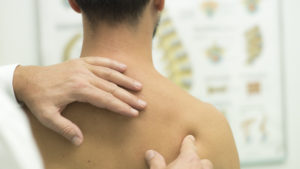
As part of my 8-week vegan body transformation, not only am I doing vigorous training in the gym 4-5 times a week, I’m also seeing a therapist for a sports massage. Even though it sounds like a rewarding spa treatment after putting in some hard work in the gym, it’s far from it.
My massage therapist during the challenge is David Matthews who’s been working at the YMCA since 2003. Matthews has previously worked in holistic and Thai massage, and he now specialises in deep tissue and sports massage.
Bad posture
During my first session with David, he analysed my standing posture from front, side and behind. Immediately he could tell what he would need to work on. This was all a surprise to me. I wasn’t attending this massage due to an injury, but part of the package of my training session.
Turns out, after a short discussion I remembered I injured my back from a gym session in 2007 and briefly again in 2016, but it’s not bothered me since. I healed up and moved on. However, the combination of my youth hunched over a computer with my adult working life, once again, hunched over a computer, my posture has developed into the all-too-common shape for people in my position.
My posture is slightly hunched. A lifetime of my hands stretched over the desk and my eyes gazing into a screen slightly lower than my eyeline has slowly taken its toll.
David’s first task was to work on my pectoral major and minor muscles, which were quite tight. Performing this exercise should not only lengthen these muscles but also loosen the upper back from being pulled forward.
After this, I turned over to my front and he began to work on the shoulder blade areas (scapula) notably the infraspinatus, Teres minor and major muscles using neuromuscular therapy (NMT) and trigger point muscle energy techniques.
This essentially involved finding the tight and painful spot, and holding them down. By holding them down, breathing in and holding my breath for up to 10 seconds, then breathing out for 10 seconds, I was relieved from the pain. At this point, I should stress my earlier point: sports massage is no relaxing spa treatment.
David then worked on my latissimus dorsi muscles which is a large set of flat back muscles which stretch to arm. He lengthened them by using soft tissue release application (grip and stretch).
No squatting
My second visit to David involved another issue I was experiencing in the gym – my ability to squat. Squatting has never been a natural movement for me. I would often wonder why people would come up to my desk at work and squat to down to chat. I would be thinking to myself, ‘What are you doing? Why you doing that? Just stand… I don’t mind’.
I suggested to David that I must have tight quads which are preventing me from doing this. David started to work loosening my quads and trying trigger-point muscle energy techniques which weren’t too bad. He then worked towards my hips, where he made a discovery which put everything into perspective. I have very tight psoas muscles.
The psoas muscle is essentially two parallel muscles which runs from the lower back all the way through the pelvis and to the hip.
It also turned out that this is one of the worst places to massage. David proceeded with the usual soft tissue release application (grip and stretch one again) to the muscles. He went above the front of my pelvis, each side and then also through from the lower back.
At the time, it was a very unpleasant experience. But now, 3 sessions in and alongside my training in the gym, I feel agile and as springy. I’ve always considered sports massage something people get to recover from injury or receive at the end of a marathon, never something I’d thought would apply to everyday use.
If you’re active or inactive person, sports massage has a place for everyone’s needs and certainly worth investigating. Even if there’s slight anomalies in your posture or difficulty in certain movements. You’d be surprised what could be holding you back.

